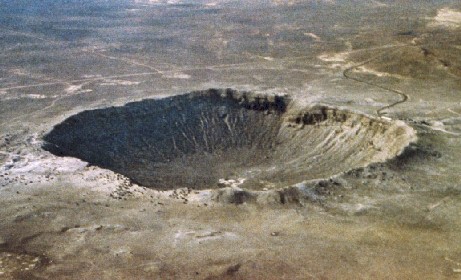Meteors and Meteorites


This crater in Arizona was caused by a 30 m wide, 100,000 ton meteor. The impact crater is 1.1 kilometers wide and 200 m deep. (Source: US Geological Survey)
The term meteor for what is usually called a shooting star bears an unfortunate resemblance to the term meteorology, the science of weather and weather forecasting. This resemblance is due to an ancient misunderstanding that wrongly considered meteors an atmospheric phenomenon. Actually, the streak of light in the sky that scientists call a meteor is essentially an astronomical phenomenon: the entry of a small piece of cosmic matter into our atmosphere.
The distinction between meteors and fireballs (formerly also called bolides) is merely one of convenience; a fireball is an unusually bright meteor. Incidentally, it also means that a fireball is larger than a faint meteor.
Objects that enter our atmosphere become visible when they are about 60 mi above the ground. The fact that they grow hot enough to emit light is not due to the “friction” of the atmosphere, as one often reads. The phenomenon responsible for the heating is one of compression. Unconfined air cannot move faster than the speed of sound. Since the entering meteorite moves with 30 to 60 times the speed of sound, the air simply cannot get out of the way. Therefore, it is compressed like the air in the cylinder of a diesel engine and is heated by compression. This heat—or part of it—is transferred to the moving object. The details of this process are now fairly well understood as a result of reentry tests with ballistic-missile nose cones.
The average weight of an object producing a faint shooting star is only a small fraction of an ounce. Even a bright fireball may not weigh more than 2 or 3 lb. Naturally, the smaller objects are worn to dust by the passage through the atmosphere; only rather large ones reach the ground. Those that are found are called meteorites. (The meteor, to repeat, is the term for the light streak in the sky.) Thousands of meteorites fall to Earth each year.
The largest meteorite known is still embedded in the ground near Grootfontein in southwest Africa and is estimated to weigh 70 tons. The second-largest known is the 34-ton Anighito (on exhibit in the Hayden Planetarium, New York), which was found by Admiral Peary in 1892 at Cape York in Greenland. The largest meteorite found in the United States is the Willamette meteorite (found in Oregon, weight ca. 15 tons), but large portions of this meteorite weathered away before it was found. Its weight as it struck the ground may have been 20 tons.
All these are iron meteorites (an iron meteorite normally contains about 7% nickel), which form one class of meteorites. The other class consists of the stony meteorites, and between them there are the so-called stony irons. Tektites consist of silica-rich glass similar to our volcanic glass obsidian, and because of the similarity, there is doubt in a number of cases whether the glass is of terrestrial or of extraterrestrial origin.
Though no meteorite larger than the Grootfontein is actually known, we do know that Earth has, on occasion, been struck by much larger bodies. Evidence for such hits are the meteorite craters, of which an especially good example is located near the Cañon Diablo in Arizona. Another meteor crater in the United States is a rather old crater near Odessa, Tex. A large number of others are known, especially in eastern Canada; and for many “probables,” meteoric origin has now been proved. Some scientists theorize that the mass extermination of dinosaurs from the face of Earth 65 million years ago was due to a large meteor that struck our planet at that time.
Meteor showers are caused by multitudes of very small bodies traveling in swarms. Earth travels in its orbit through these swarms like a car driving through falling snow. The point from which the meteors seem to emanate is called the radiant and is named for the constellation in that area. The Perseid meteor shower in August is the most spectacular of the year, boasting, at peak, roughly 60 meteors per hour under good atmospheric conditions. The presence of a bright moon diminishes the number of visible meteors.







